
Who Cares About Comics, Anyway?
August 5th, 2008 Posted by david brothersComics are a bastard medium.
It isn’t fine art. Even the commercial art doesn’t quite stick– it’s for sale, yeah, but it’s still somewhere between the two.
Comics are for children. They feature men in tights re-enacting the same simple good versus evil fights they’ve been doing for decades. How deep do you think Batman vs the Joker really goes? Don’t even try to play the “graphic novel” card– graphic novels are just comics with a spine.
The time of comics being worth a grip of money is over, too. It kind of blows my mind when I see people buying variant books for twenty bucks. I have trouble paying more than ten cents a page– why would you go for a dollar a page? Do you really expect that much of a return on your investment? That comic is worthless, son, and it isn’t going to make you money. The ’90s are dead and gone.
Comics are the red-headed stepchild of Hollywood. How many IP farms are out there now? How many people write comics that are obviously movie pictures or storyboards in sequential art form? How many Hollywood writers drop in, dabble a bit, and drop back out, sometimes mid-series? Hollywood options are big news these days– why? Easy: Hollywood is where the money is, friends. Money talks.
Comics are a bastard medium. Not quite fine art, not quite commercial art. Disrespected, not respected, and used as a stepping stone. What do comics have to lose? Nothing at all.
Why not take greater advantage of that?
I love Gotham Central. It’s a great little police procedural. Everything from the writing down to the art clicks. But, take a look at it. It looks like it could have been The Wire or The Shield. It’s staged and laid out like a TV show. It’s got realistic angles, establishing shots, and pretty realistic looking characters. This could’ve easily been a TV show. I’m not dissing or anything. The realism is a point of pride for the series, I’m sure.
Comics can do Hollywood. Hollywood is easy. However, can Hollywood do this?






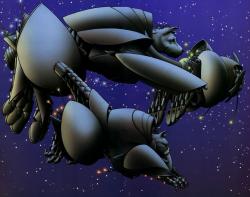
Look at that. Hyper-compressed information dump gives way to a wonderfully wide open two page spread. The eighteen panel grid is positively claustrophobic. The lack of words and panel size forces you to take your time and pore over each panel. The panels even reflect the reality of the situation. They’re inside an oppressive military facility, and when they escape? A wide open breath of fresh air.
What about the insane style switches in Seven Soldiers #1?
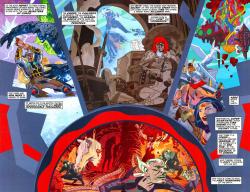
Comics can do so much that movies cannot. However, the general style at the Big Two, and even beyond, tend to stick to realism. Chris Bachalo and Humberto Ramos are a nice look, but work by them, and those like them, is fairly rare.
David Aja made wonderful use of the comics page in his work on Immortal Iron Fist. He kept the straight-forward, realistic storytelling and flipped it. Each strike gets its own panel. Iron Fist dances around the comics page in a scene that would take a split second of action in a movie. He makes the page part of the story.
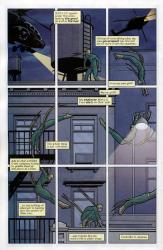
I loved We3. There are a ton of little narrative tricks and details that force you to read the book slowly and take it all in. The spread above, of the animals attacking the soldiers, is more exciting than bullettime was when the Matrix hit. Every single action gets its place in time. If you look at the panels in order, it’s like looking at a film strip.
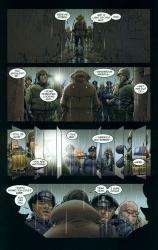
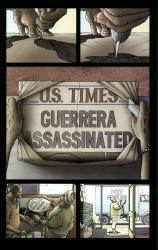
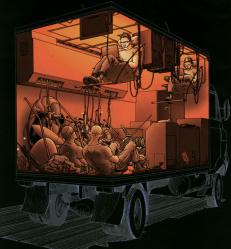
No one cares about comics, so comics can get away with a lot. Grant Morrison’s Flex Mentallo is one of my favorite comics. It tells the tale of a forgotten superhero and how you can make fiction a reality. It’s a love letter to comics and it flits from era to era over the course of the series. It’s brave.
We need more Flex Mentallos. Tell a story that might not sell, but is worth the time. Marvel’s started moving in this direction with their revamped Marvel Knights series. Who’d have thought that a story about Daredevil’s Dad would be an excellent comic?
There’s a lot of attention paid to continuity, as well. Things have to line up just so or else the story is ruined.
Screw that.
Keep the stories internally consistent, but go wild. I may not like Marvel Zombies very much, but I can respect what it represents. Take advantage of the fact that most of these characters are unbreakable. Toss Captain America into 1602, sure. Pop Spider-Man into feudal Japan. What if Luke Cage was in his ’20s in 1930s Harlem? What did the Black Panther cult do to fight colonization in Africa?
Take your characters and bend them. If they break, guess what– you can just dial it back to what it was before. You don’t need Continuity Patch Comix. Fans aren’t stupid. If you say “That was then, this is now,” they will assuredly grumble. They’ll grumble regardless, to be honest. But, they’ll get over it. They always do.
Spider-Man made it through the Clone Saga. Batman made it through the ’90s. Luke Cage, Ms. Marvel, Emma Frost, and a host of other d-list characters are headlining now. You can’t break these characters, so don’t treat them like fine china. Throw them against the wall. They’ll bounce back.
Comics need to start acting like comics. No one expects anything out of them but a story that goes from A to B to (sometimes) C. If no one expects anything out of you, you’re free to do what you like.
We need more Seth Fishers.
